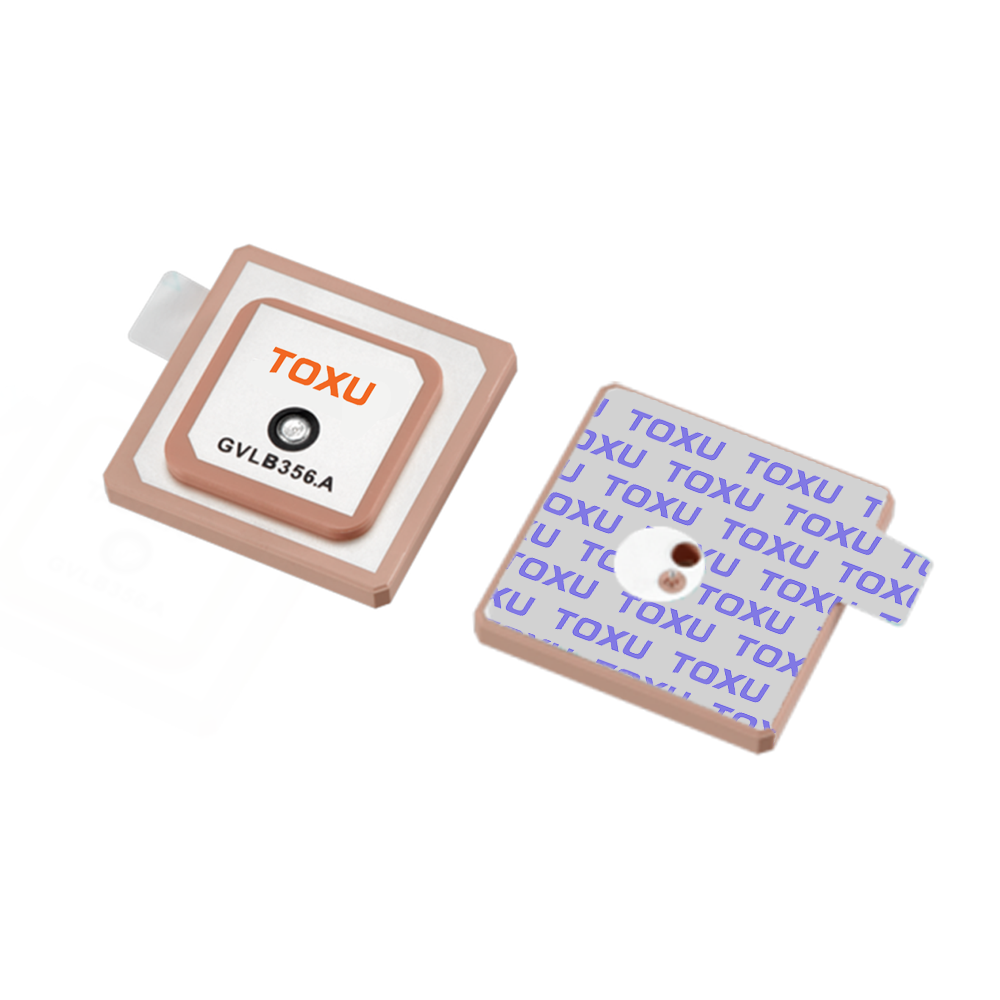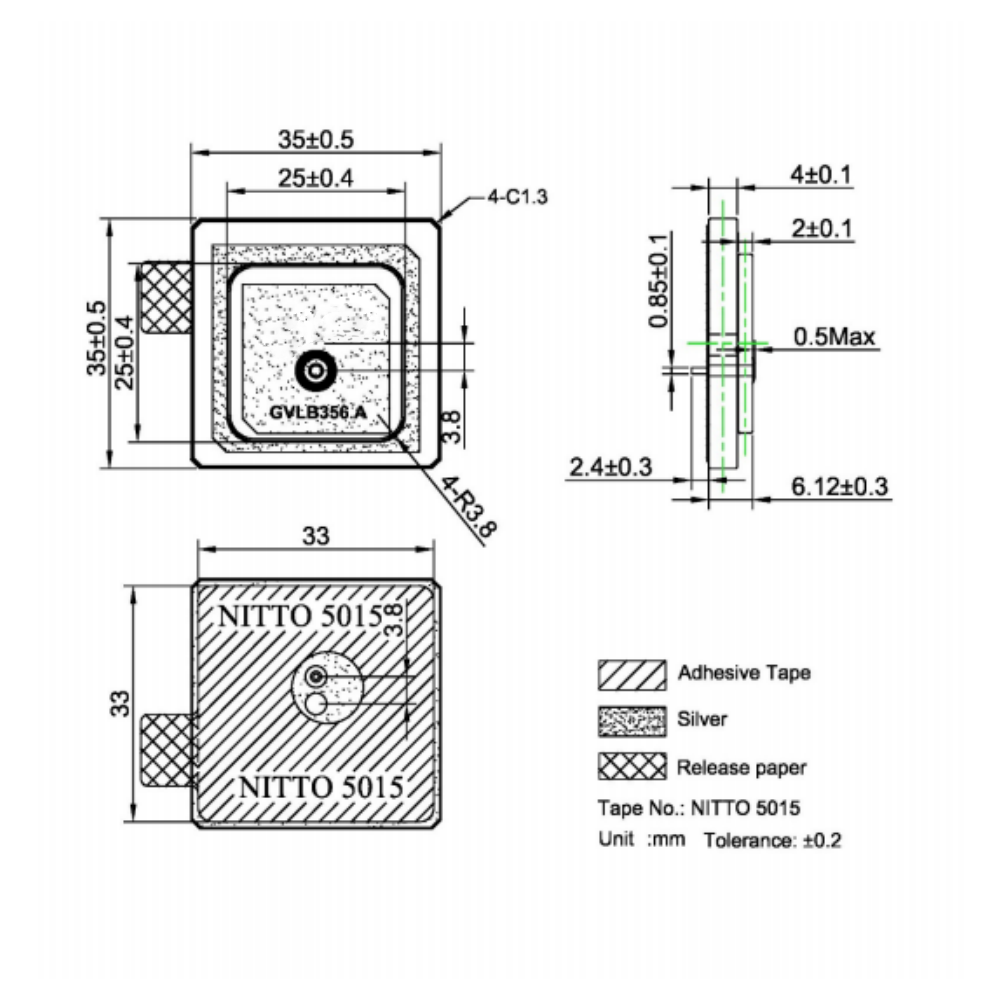antenna’s design
At the heart of this antenna’s design is its ceramic patch construction, a technology that has revolutionized compact GNSS applications. Ceramic materials, particularly those with high dielectric constants, offer a distinct advantage: they allow for the miniaturization of the antenna without sacrificing signal reception capabilities. The patch dimensions of 35356.12 mm exemplify this benefit, providing a low-profile, space-efficient solution that can be seamlessly integrated into devices with limited real estate. Whether embedded in the casing of a smartwatch, mounted on the frame of a small drone, or integrated into the dashboard of a vehicle, the antenna’s compact form factor ensures it does not compromise the device’s design or functionality. The ceramic substrate serves as a stable platform for the conductive patch, maintaining consistent performance across varying temperatures and environmental conditions. Unlike bulkier antenna designs, which may hinder portability or aerodynamics, this ceramic patch antenna balances size and performance, making it ideal for applications where every millimeter counts.
The antenna’s connectivity via a pin feed (passive) design is a key feature that enhances its reliability and simplicity. As a passive antenna, it lacks an internal amplifier, relying instead on the connected receiver’s front-end circuitry to amplify incoming signals. This design eliminates the need for an external power source, reducing complexity in integration and minimizing power consumption—a critical advantage for battery-operated devices. For example, in a fitness tracker or a portable GPS unit, the passive design helps extend battery life, ensuring the device can operate for longer periods between charges. The pin feed mechanism itself ensures a direct, low-loss connection to the receiver, preserving signal integrity as radio frequency (RF) energy travels from the antenna to the processing unit. While active antennas with built-in amplifiers can boost weak signals, they introduce additional components that may generate noise or fail under harsh conditions. The passive design of this ceramic antenna avoids such risks, making it a durable choice for environments where signal clarity and reliability are paramount.
Right-hand circular polarization (RHCP) is a critical attribute that aligns the antenna with the characteristics of GNSS satellite signals, which are intentionally broadcast with circular polarization. This alignment is essential for minimizing signal loss due to polarization mismatch, a common issue in linearly polarized antennas. When a linearly polarized signal reflects off surfaces like buildings, terrain, or water, its polarization can rotate, leading to attenuation if the receiving antenna is not similarly polarized. RHCP ensures that the antenna can effectively receive signals even after such reflections, as the circular polarization’s rotation direction remains consistent. This is particularly valuable in challenging environments such as urban canyons, dense forests, or coastal areas, where multipath interference is prevalent. While the antenna’s axial ratio of 11.2-17.04 dB indicates a deviation from perfect circular polarization (which would have an axial ratio of 0 dB), it remains sufficient for most consumer and industrial applications. The axial ratio, which measures how elliptically polarized the signal is, is balanced here to ensure adequate reception across the supported frequency bands, even if it is not perfectly circular.
The antenna’s frequency coverage
The antenna’s frequency coverage—encompassing GPS L1 (1575.42 MHz), GPS L5 (1176.45 MHz), BeiDou B1 (1561.098 MHz), and GLONASS G1 (1602 MHz)—positions it as a versatile solution for multi-constellation navigation. GPS L1 is the primary civilian frequency, widely used in everyday applications like car navigation and smartphone mapping. GPS L5, a newer frequency, offers improved resistance to interference and better accuracy, making it ideal for safety-critical applications such as aviation and autonomous driving. BeiDou B1 and GLONASS G1 extend compatibility to China’s and Russia’s satellite systems, respectively, enhancing redundancy and ensuring reliable positioning in regions where certain constellations may be stronger. For instance, in parts of Asia, BeiDou signals may be more robust than GPS, while in Russia, GLONASS may offer better coverage. By supporting multiple frequencies and constellations, the antenna reduces the risk of signal loss due to atmospheric conditions, satellite outages, or geographic limitations, ensuring continuous operation in diverse scenarios.
The voltage standing wave ratio (VSWR) of 2:1 to 4:1, varying by frequency band, is a key indicator of the antenna’s efficiency in transferring RF power to the receiver. VSWR measures the mismatch between the antenna’s impedance and the characteristic impedance of the connecting cable (typically 50 ohms). A lower VSWR (closer to 1:1) indicates better matching, meaning less power is reflected back and more is transferred to the receiver. The variation in VSWR across bands is normal, as antenna performance can differ slightly at different frequencies. For example, the antenna may exhibit a VSWR of 2:1 at GPS L1, where it is optimized, and 4:1 at GLONASS G1, which is at the edge of its frequency range. Despite this variation, the VSWR remains within acceptable limits for most applications, especially when paired with a receiver that can compensate for minor mismatches. The antenna’s design ensures that even with these fluctuations, sufficient power is transferred to maintain reliable signal reception and processing, avoiding the signal degradation that would compromise positioning accuracy.
Peak gain of up to 4.03 dBi and efficiency of up to 79.93% highlight the antenna’s ability to capture and convert RF energy into usable signals. Gain, measured in dBi (decibels relative to an isotropic radiator), indicates how well the antenna focuses energy in a particular direction. A peak gain of 4.03 dBi, while modest compared to high-gain directional antennas, is well-suited for the antenna’s omnidirectional radiation pattern, which allows it to receive signals from satellites across a wide portion of the sky. This balance is critical for mobile applications, where the antenna’s orientation can change rapidly—such as in a moving vehicle or a drone in flight—requiring it to track satellites in multiple directions. Efficiency, which measures the percentage of input power converted to radiated power, is exceptionally high at 79.93%, indicating minimal loss within the antenna itself. This high efficiency ensures that even weak signals from low-elevation satellites are captured and transmitted to the receiver, enhancing performance in challenging environments where satellite visibility is limited.
The omnidirectional radiation pattern
The omnidirectional radiation pattern is a defining feature that makes the antenna suitable for dynamic applications where the antenna’s orientation is not fixed. Unlike directional antennas, which focus reception in a specific direction, an omnidirectional pattern allows the antenna to receive signals from satellites above, in front, behind, and to the sides, within a certain elevation range. This is particularly important for devices like smartphones, which are often held at varying angles, or drones, which pitch, roll, and yaw during flight. The radiation pattern ensures that as the antenna moves, it maintains contact with enough satellites to calculate a precise position. While omnidirectional antennas typically have lower gain than directional ones, the trade-off is worthwhile for applications requiring flexibility and adaptability. The antenna’s design optimizes this pattern to cover the sky effectively, with sufficient gain at low elevations to track satellites near the horizon—critical for maintaining a strong satellite lock in urban areas or mountainous terrain.
The ground plane size of 7070 mm is a critical design consideration that influences the antenna’s radiation pattern and efficiency. A ground plane is a conductive surface (usually metal) placed beneath the antenna, which helps reflect RF energy upward, shaping the radiation pattern and improving performance. The 7070 mm ground plane provides a stable platform for the 3535 mm ceramic patch, ensuring that the antenna’s radiation pattern is consistent and focused toward the sky. A larger ground plane could potentially improve performance but would increase size and weight, which are undesirable for portable applications. The 7070 mm dimensions strike a balance, ensuring optimal performance without excessive bulk. Additionally, the ground plane helps shield the antenna from electromagnetic interference (EMI) from nearby electronic components, such as a smartphone’s processor or a drone’s motor, further enhancing signal clarity and reducing noise.
The antenna’s weight of 26g is another factor that enhances its suitability for portable applications. In devices where weight is a critical consideration—such as wearables, lightweight drones, or handheld surveying tools—a heavy antenna can compromise functionality, reducing battery life or maneuverability. At 26g, this ceramic antenna adds minimal burden, ensuring that the host device can operate efficiently without sacrificing performance. This lightweight design is achieved without compromising durability, as the ceramic material is inherently robust and resistant to physical stress, making the antenna suitable for use in rugged environments.
The operating and storage temperature range of -40°C to +85°C underscores the antenna’s ruggedness and suitability for extreme environments. From freezing Arctic conditions to scorching desert heat, the antenna maintains its performance, ensuring reliable positioning regardless of temperature fluctuations. This durability is achieved through the use of high-quality materials: the ceramic patch is resistant to thermal expansion and contraction, while the conductive elements are designed to withstand extreme temperatures without degradation. This wide temperature range makes the antenna ideal for outdoor applications, where environmental conditions are often unpredictable. Whether mounted on a vehicle navigating a snowstorm or a drone flying over a desert, the antenna remains reliable, ensuring consistent positioning data when it matters most.
applications
-
In practical applications, the GNSS Ceramic Antenna excels across a wide range of scenarios. In consumer electronics, it enables accurate location tracking in smartphones, smartwatches, and fitness trackers, powering features like turn-by-turn navigation, geotagging, and activity monitoring. Its compact size and low power consumption make it ideal for these devices, where space and battery life are at a premium. In industrial settings, the antenna is used in surveying equipment, allowing professionals to collect precise location data for construction, mapping, and land management. Its multi-frequency support and omnidirectional pattern ensure that surveyors can work efficiently even in challenging environments, such as urban construction sites or remote wilderness areas.
For drones, the antenna’s lightweight design, omnidirectional pattern, and wide temperature range make it a reliable choice for aerial photography, agricultural monitoring, and search and rescue operations. Drones equipped with this antenna can maintain stable positioning even during rapid maneuvers or in varying weather conditions, ensuring safe and accurate flight. In automotive applications, the antenna supports in-car navigation systems and advanced driver-assistance systems (ADAS), providing the precise location data needed for features like lane-keeping assist and adaptive cruise control.
Looking ahead, as GNSS technology continues to evolve—with the expansion of constellations like BeiDou and Galileo, and the adoption of new frequencies for improved accuracy—the GNSS Ceramic Antenna is well-positioned to adapt. Its multi-frequency support ensures compatibility with future satellite systems, while its compact design and robust performance make it suitable for emerging applications such as autonomous vehicles, smart cities, and the Internet of Things (IoT). In these applications, reliable, low-power positioning is essential, and the antenna’s passive design, high efficiency, and wide temperature range make it a compelling choice.
In conclusion
-
In conclusion, the GNSS Ceramic Antenna is a versatile, reliable, and efficient component that plays a critical role in modern navigation systems. Its ceramic patch design, passive connectivity, and multi-frequency support make it ideal for a wide range of applications, from consumer electronics to industrial tools. With features like RHCP polarization, an omnidirectional radiation pattern, and a rugged construction that withstands extreme temperatures, the antenna ensures accurate positioning even in challenging environments. As the demand for precise, reliable location data continues to grow, the GNSS Ceramic Antenna will remain a key enabler, bridging the gap between satellites and the devices that depend on them for navigation, monitoring, and control.




































































 Language
Language
 En
En Cn
Cn Korean
Korean

 Home >
Home > 







 18665803017 (Macro)
18665803017 (Macro)













